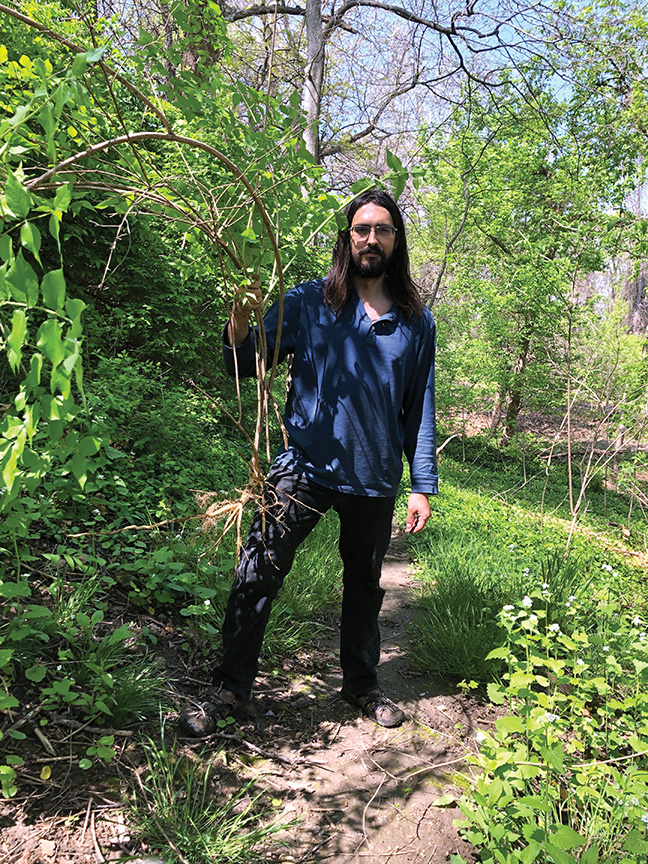
Dorri Partain
Contributor
Cliff Drive has been Kansas City’s connection to nature for more than 100 years, but the landscape has changed greatly during that time. Invasive plants such as bush honeysuckle, trees of heaven, wintercreeper, and Japanese knotweed have taken hold and crowded out the native species that once grew there.
In recent years, local volunteers have taken on the task to remove those invasive plants, originally to make it easier to remove the ongoing trash and litter that accumulates and ruins the natural beauty of the area. Pendleton Heights residents took on the herculean task to clear the area of invasives, especially bush honeysuckle, around the Gate 2 entry to Cliff Drive, only to discover their efforts were mostly for naught – the invasives grew quickly back.
That’s when a new project was developed by Wil Oden, a six year resident of the neighborhood. Instead of just cutting back the invasives, which also led to erosion issues, native plants needed to be planted in their place.
Native plants are those that grow here naturally, and spread by reseeding. They are accustomed to the climate of the area and provide shelter and food to create a diverse natural landscape.
As Odin explained, “There are different layers to a forest. The canopy still has a good amount of native trees. It’s the understory and floor that developed those issues with the overtaking of invasives; restoring those natives, we’ll begin to see a diversity, not just in plants but in the wildlife that will be attracted back to the area as well.”
Odin is self-taught in the realm of local forests. By day his occupation has him tackling facts and figures as an accountant. Along the way, he’s had assistance from the Kansas City Parks and Recreation Department, providing mulch and herbicide, and the Missouri Department of Conservation, which supplied a grant of $8,500 to purchase the necessary trees and provide water to keep them growing over a several year period.
Numerous groups have done the heavy task of removing the invasives, which includes applying herbicides to kill roots and chopping away at roots with pickaxes for very stubborn species, such as Japanese knotweed. Work began last fall, and a section Odin refers to as Area 2 was completed in January. In April, volunteers were back to spread mulch, and new bare root trees were planted on April 9 and 11. Planting scheduled for April 10 was rained out, but it meant the new trees were watered the natural way. During times of drought, Odin will be able to use a watering truck supplied by the Independence Avenue Community Improvement District (CID), used to water their plantings along the avenue.
Trees planted include a mix of 50 varieties: spicebush, pawpaw, mulberry, cottonwood, hickory, wild plum, sumac, and twelve different varieties of oak, for a total of 1,250 planted this spring.
“Density is super important at this stage because only 20 to 30% will survive,” Odin explained. “Basically we’re overplanting to ensure that we get that variety to take hold and be sustainable in the next two years.”
The number of trees and shrubs planted might seem like a daunting number, but with 15-16 volunteers, they could plant up to 800 trees a day. He marked the area with a grid to simplify planting, with one worker making a hole and another placing the plant as they worked down the slope. To ensure diversity, they planted one tree species, one shrub species, a different tree species of the various varieties, one to two feet apart.
While Area 2 is described as a forest, two other areas will be completed in the coming years, with one area being developed as a savannah and the other as a bog, with trees and flowers common to those landscapes. All project areas are in the vicinity of Cliff Drive Gate 2.
Jerusalem Farms provided AmeriCorp volunteers who have overseen a large part of the work in Area 2. Other groups that have pitched in include Just People Doing Good Things, Global FC, Burns & McDonnell, Urban Trail Company and residents of Pendleton Heights.
Work will continue this fall as volunteers return to complete the next segment of this multi-year project, the planting of native flowering forbs. Sixty-two pounds of seed mix will be spread under and around the new trees, including columbine, sideoats grama, little bluestem, Jacob’s ladder, cardinal flower, plains coreopsis, and blue lobelia. While the cleared and newly planted area still looks barren, the trees are now leafing out, and by next spring when the seeds sprout, the area will look lush and colorful.
Odin checks on the newly planted area, on a hillside by golf disc hole number 5, several times a week, mainly to water the trees and shrubs, but also pick up trash and pull up bush honeysuckle. For individuals or groups that would like to participate, they can contact him by email at Willerific@aol.com.


















